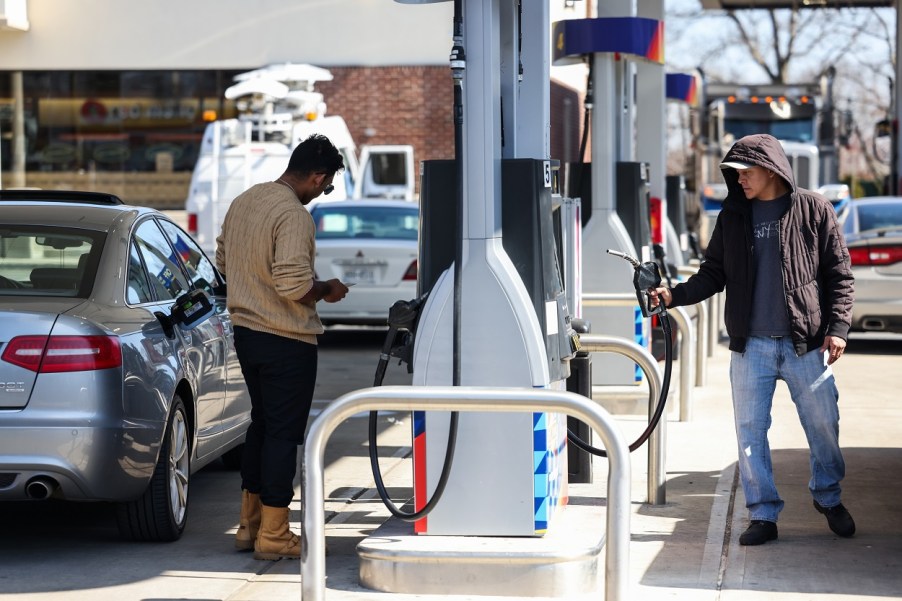
What is MPG? Try Gallons-Per-Mile Instead
MPG stands for Miles per gallon – or miles driven divided by miles traveled. It is a way of measuring a car’s fuel economy. However, it’s time to think differently about your gas mileage. We know that prices at the pump are high, but what’s the best way to calculate MPG?
With an average of $4.24 across the nation, according to AAA, and we’re all feeling the squeeze when we fill up. But there’s a better way to think about your mileage when you’re buying a new car, truck or SUV: gallons per 100 miles. In Europe, they measure a car’s efficiency this way and maybe it’s time we started to, also, in the U.S. of A.

Why should we use gallons per 100 miles, and not MGP?
Let’s assume you have a 10-mile commute, and you drive 20 miles per day, or 100 miles per week for easy math. To figure out how much gas it would take to make your daily commute If your car gets 22 miles per gallon is a long division problem that most of us forgot how to figure out at the same time we forgot how to make friendship bracelets. It’s miles driven, divided by gallons used, for a refresher. But nobody thinks like that. When was the last time you told the pump jockey at your local 7-11 that you wanted 11 gallons of premium, not “$40 on pump three?”
Instead, look at gallons per mile to find the true cost of your driving, then multiply by 100, even if you are following the guidelines for better fuel economy.
In its real-world driving test, Car and Driver found that a Ram 1500 TRX gets 13 mpg, which means that it takes 7.69 gallons to drive 100 miles, or about $32. But, if it got just two MPG better, say 15 mpg like the F-250 Super Duty, it would take 6.67 gallons, or $28 to go that same 100. But, if it gets 42 mpg, like the new Ford Maverick, then it takes just 2.38 gallons, or only $10.01 to drive 100 miles.
The difference between taking your TRX to the lake or a new Maverick could be $22, and that buys a few extra Coronas.
MPG = Miles Driven ÷ Gallons Used
.
The rest of the world uses liters per kilometer, not MPG
In Europe, they use liters per kilometer – or miles per imperial gallon in England — to determine a car’s efficiency. Several magazines, such as Popular Mechanics, use gallons per mile to determine a car’s efficiency. The EPA does, too, and it’s much easier to see and calculate your 100-mile commute that way.
You can find the gallons per 100 miles rating easily on the window sticker, right below the miles per gallon rating. For example, a new F-150 is rated at 22 miles per gallon from the EPA, but 4.5 gallons per 100 miles, so it would cost you $19.08 for that weekly commute. A Ranger with the 2.3 liter Ecoboost gets the same gallons per 100 miles rating. But, an Escape S with the 1.5 liter Ecoboost gets 3.3 gallons per 100 miles, meaning it only costs $13.99 to commute. So, it would cost you $5.09 less a week, or $264.68 less annually to commute in an Escape S. Try that math in MPG and it gets hairy very quickly.

Research Proves that MPG doesn’t tell the whole story
Professors Richard Larrick and Jack Soll, according to Science Daily found that “most people ranked an improvement from 34 to 50 mpg as saving more gas over 10,000 miles than an improvement from 18 to 28 mpg, even though the latter saves twice as much gas.”
The math works out to mean that going from 34 to 50 miles per gallon saves just 94 gallons of gas, while going from 18 to 28 miles per gallon saves 198 gallons, according to Science Daily. That’s almost $840 over 10,000 miles, at today’s average gas price of $4.246, according to the American Automobile Association, or $1,171 if you’re unlucky enough to live in California.
It’s also fairly easy to find your gallons per mile rating by visiting FuelEconomy.Gov. At the EPA’s site you can compare two vehicles’ ratings side by side, and see their miles per gallon estimates, as well as gallons per 100 miles, like in this comparison of a Toyota RAV 4 Hybrid AWD and a Hyundai Palisade AWD.

In that Science Daily piece, though the research may be a bit dated, the professors noted that the most efficiencies come from improving the efficiency of the least efficient vehicles, like a TRX or a Raptor, instead of the most fuel-efficient vehicles.
It’s time to start looking closer at your window stickers and start doing the much-simpler math on gallons per 100 miles to determine the real-world cost of how much your commute costs, or that trip to the lake.


